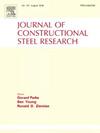Microstructure, tensile property and corrosion performance of GTAW 316 L/Q345 under compound-magnetic field
IF 4
2区 工程技术
Q1 CONSTRUCTION & BUILDING TECHNOLOGY
引用次数: 0
Abstract
In order to investigate the regulation law of compound-magnetic field on the weld quality of dissimilar steels with significant material property differences. This study applied compound-magnetic field to gas tungsten arc welding (GTAW) 316 L/Q345 dissimilar steel welding. The compound-magnetic field is generated by longitudinal excitation current (IL) and cusp excitation current (IC) in the excitation coil. The forming, microstructural evolution, tensile property and corrosion performance of weld metal (WM) under different excitation parameters were studied by Leica microscope, electron backscatter diffraction (EBSD), electronic general test equipment, electrochemical measurement, scanning electron microscopy (SEM), X-ray diffraction (XRD) and energy dispersive spectrometer (EDS). Study results show that:compared with No external magnetic field (EMF), under the influence of compound-magnetic field, the weld formation was significantly improved. The base metals fusion ratio were similar and the penetration was maximum when IL = 0.5 A & IC = 5 A; The microstructure changed from martensite to martensite + residual austenite, and the grains are significantly refined; The tensile fracture mode changed from brittle fracture to mixed fracture; The best tensile properties were obtained at IL = 0.5 A & IC = 3 A, with the ultimate tensile strength (UTS) and elongation (EL) being 1073.27 MPa and 6.86 %, respectively, which were 39.9 % and 68.6 % higher than those of No EMF; The residual austenite, high content of Cr and Ni elements and grain refinement in WM significantly improved the density of rust layer. WM had the best corrosion resistance when IL = 0.5 A & IC = 3 A.
求助全文
约1分钟内获得全文
求助全文
来源期刊

Journal of Constructional Steel Research
工程技术-工程:土木
CiteScore
7.90
自引率
19.50%
发文量
550
审稿时长
46 days
期刊介绍:
The Journal of Constructional Steel Research provides an international forum for the presentation and discussion of the latest developments in structural steel research and their applications. It is aimed not only at researchers but also at those likely to be most affected by research results, i.e. designers and fabricators. Original papers of a high standard dealing with all aspects of steel research including theoretical and experimental research on elements, assemblages, connection and material properties are considered for publication.
 求助内容:
求助内容: 应助结果提醒方式:
应助结果提醒方式:


